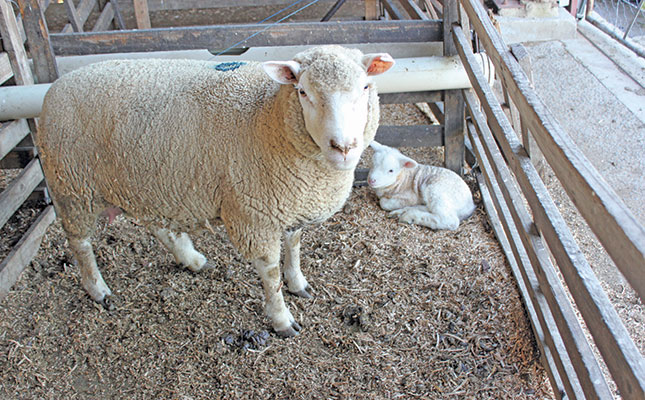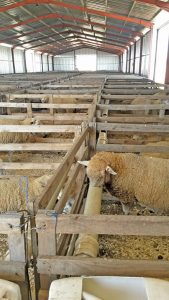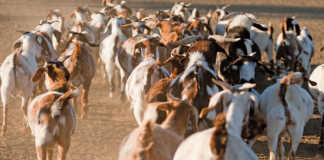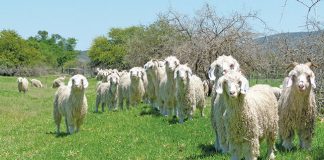
Photo: Supplied
For Regina Harmse, who runs the RCH Ile de France Stud on the farm Uitgezocht near Ermelo, improving the quality of her animals is a non-negotiable. With approximately 1 000 Ile de France ewes split 50/50 between stud and commercial herds, she has to run an intensive, hands-on operation in order to turn a profit.
And for this to happen, maintaining the highest possible lambing and weaning percentages is essential. For this reason, lambing pens are a key part of her operation.
Common misconceptions about lambing pens are that a farmer can use them to turn bad mothers into better ones, or that the system breeds the mothering instincts out of ewes.
Harmse says the truth is that a lambing pen system is an invaluable tool for growing a flock and increasing revenue, as it enables a producer to boost weaning percentages and lower lamb mortality rates.
And while it won’t sort out problem animals, a lambing pen system allows for the easier selection of genetics for better mothering ability. She adds that it is the farmer’s task, after all, to notice those ewes that show poor maternal ability and to cull them accordingly.
Close observation
A lambing pen system calls for a short lambing period (a maximum of 35 days) to mitigate animal feed and labour costs.
According to Harmse, the majority of lamb deaths take place in the first three days after birth. Small lambs are ideal prey for predators such as the black-backed jackal and caracal and, in the case of many communal farmers, feral dogs.
High concentrations of ewes in a single camp, the number of lambs born per day, and environmental conditions also add to lamb mortality rates. The more ewes in a camp and the higher the number of lambs born per day, the greater the need for a detailed and more intricate management structure. The ultimate objective of a well-functioning lambing system, therefore, is to keep note of every ewe and lamb during lambing season.
“The Ile de France breed is known for its ability to produce multiple births, which requires increased management and control. This is necessary for the long-term sustainability of the operation, as multiple births increase reproduction and growth rates significantly.
“Lambing pens make it possible for the farmer to monitor individual lambs and ewes consistently and regularly. One very important aspect of pens is that they enable a lamb to suckle within three hours of its birth, which is crucial for the bonding process between the ewe and the lamb,” she says.
Colostrum is the first form of milk produced by mammals immediately following the birth of their young. It contains antibodies that protect the newborn animal against disease and infection, as well as immune cells and growth factors that help activate the young animal’s immune system and ensure health, growth and vitality. The sooner a lamb ingests colostrum, the better.
Through regular monitoring of the penned ewes, any problems they might have, such as blocked teats, can be observed early enough to prevent permanent damage. Blocked teats are notorious for causing a marked drop in milk production and, consequently, a spike in lamb mortality.
Teat health is essential for the survival of both ewes and lambs. Bacteria that enter the teat following suckling can cause infections such as mastitis. Keeping ewes in pens makes the timely detection of diseases and other ailments possible.
Pen specifications
Harmse says the average lambing pen should be no smaller than 1,5m x 1,5m x 0,9m. A pen of this size will accommodate a ewe and her offspring comfortably. The actual size of the pen, however, will depend on the breed of sheep and whether the ewe is carrying a singleton or multiple lambs.
Food and water containers should be attached to the wall of the pen to free up floor space for the animals.

The choice of building material is up to the farmer; steel pens, for example, are stronger, but more expensive than those made from pallet wood. However, the main objective stays the same: to prevent the lambs from escaping.
In the case of pens with earthen or cement floors, Harmse recommends that they be covered with sawdust or hay, as they can become cold and wet. Wooden slatted floors can also be used.
“In my case, the pens are roofed, and they have earthen floors that are covered with sawdust. An earthen floor is ideal for proper drainage. However, the pens must be cleaned and the sawdust replaced regularly to keep the floor surface dry.
“It’s also advisable to disinfect the pens with lime before putting in the sawdust or hay. The main point is that the pens must be designed so that the animals are protected from the elements and provided with shade.
“Flying and biting insects should also be controlled to protect the animals against bacteria and disease.”
Animal health
The umbilical cord is a potential problem with lambs and needs to be monitored and treated if required. The open navel can serve as a point of entry for bacteria and a direct route to the liver. It is therefore crucial to thoroughly disinfect a newborn lamb’s umbilical cord with iodine, and keep the pen hygienic.
With lambs born in pens, this entire process is far easier.
Vaccination is key to the health of the ewe (and her lamb) during gestation, throughout parturition, and when she is lactating. Pregnancy suppresses the level of immunity in the ewe, which reduces the protection that she and her unborn lamb have from debilitating and deadly diseases.
During this period and throughout lambing, the ewe will be protected from the diseases that she has been vaccinated against.
When the ewe is vaccinated at two to four weeks before lambing, the maternal antibodies in the form of colostrum are produced in the udder. When the colostrum is consumed by the lamb within the first 48 hours of birth, these maternal antibodies safeguard the animal from the corresponding diseases for six to 10 weeks. This is essential to protect the lamb from death and illness until its own immune system becomes fully functional.
For the pre-lamb vaccine to be effective, it must be administered correctly, as per label instructions. Harmse advises farmers to use Multivax-P to prevent pasteurellosis, pulpy kidney, tetanus, malignant oedema and blackquarter, amongst other diseases.
She also recommends Onderstepoort Biological Products’ vaccination against blue udder. No live vaccines should be used during gestation, as they could lead to high fever, followed by abortions.
However, it is essential that ewes be dewormed about a week before lambing. Trace elements are indispensable to ensuring high lambing rates and weaner weights, and the demand for manganese, zinc, copper and selenium in particular spikes markedly during pregnancy.
These elements play a vital role in foetal development (especially during the final stages of pregnancy) and, ultimately, the survival rate of lambs, due to the elevated levels of such elements provided through the ewe’s milk.
Body condition and well-being
It is obvious that in-lamb ewes should be kept in the best possible condition. However, it doesn’t make sense to start building up the condition of lean ewes during the last six weeks of gestation, as there is a good chance that this will result in lambing problems.
“What usually happens is that the foetus grows too big for safe lambing,” says Harmse.
“The ideal is to supply the ewe with a ration of between 450g and 500g every day from the onset of the lambing season, and to increase this by 250g to 300g every seven days.
“The daily ration for single-lamb ewes should not exceed 1,5kg, and multiple-lamb ewes should not receive more than 2kg daily before lambing. Bypass protein should be provided during late pregnancy to improve mothering ability, increase growth rate, enhance the quality of the colostrum, and prevent lambing problems.”
For penned ewes, Harmse recommends a feed mixture of 375kg milled lucerne, 350kg
milled maize, 150kg Voermol Maxiwol Concentrate, 50kg Voermol Procon 33 and 80kg Voermol Molasses Meal supplied daily at 1,5kg to 2,5kg for each ewe.
“Because we synchronise the breeding animals, we can determine the ewes that were mated during the first and second mating cycles. As soon as the first ewe lambs, she and the rest of her group are penned, and it’s here that the other lambs are born.
“It’s particularly important to pen young ewes so they can get used to the environment, as they [tend to get more] stressed than mature ewes.”
Change of scenery
The ewes and their lambs are moved to pasture as soon as they have bonded and the young are suckling well; this usually takes three to four days in the case of singletons, and three to five days with multiple lambs.
The penned animals are released in small groups and gradually introduced into the larger flocks so the lambs can get used to higher concentrations of animals, and to make sure they can recognise their mothers well enough to stay with them.
It is advisable not to keep lactating ewes in groups of more than 100 animals. In the case of singletons, the ewes and lambs are initially kept in groups of 10 ewes for between five and seven days, then moved to groups of 20 ewes for the next five to seven days. From there, they are shifted to groups of 40 ewes for yet another five- to seven-day period.
With multiple lambs, the ewes are kept in groups of five, 10, 20, or 35 to 40. According to Harmse, there should never be more than 200 to 250 lambs and ewes in a camp, regardless of the lambing system.
Management and control
Developing and running a lambing pen system is more expensive than most other lambing systems, and this includes animal feed expenses. It is also more labour-intensive. However, the increased weaning rates mean a good return on investment.
Whether or not it is successful is dependent on proper control and sound management.
“The implementation of stringent biosecurity measures is essential because of the significant increase in cases of cryptosporidiosis. This disease has wreaked havoc in the local livestock industry, and one measure that can be taken to prevent it is not to allow any outside person to enter the pens.
“Without a strict biosecurity system, it’s virtually impossible to run a sustainable livestock production concern in South Africa,” says Harmse.













